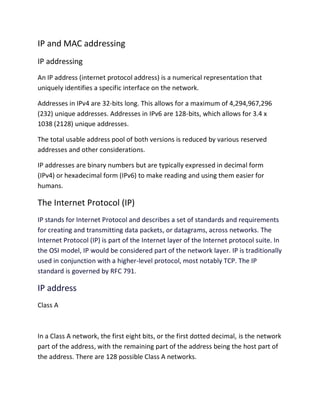Denunciar
Compartir
Descargar para leer sin conexión

Recomendados
Recomendados
Más contenido relacionado
La actualidad más candente
La actualidad más candente (20)
Computer Networking: Internet Protcol (IP) and IP Addressing

Computer Networking: Internet Protcol (IP) and IP Addressing
Similar a Ip and mac addressing
Similar a Ip and mac addressing (20)
IP Address in data communication and computer notework.ppt

IP Address in data communication and computer notework.ppt
Lesson 13University of the CumberlandsProfessor Dr. I.docx

Lesson 13University of the CumberlandsProfessor Dr. I.docx
Último
Último (20)
On National Teacher Day, meet the 2024-25 Kenan Fellows

On National Teacher Day, meet the 2024-25 Kenan Fellows
Measures of Dispersion and Variability: Range, QD, AD and SD

Measures of Dispersion and Variability: Range, QD, AD and SD
Micro-Scholarship, What it is, How can it help me.pdf

Micro-Scholarship, What it is, How can it help me.pdf
Python Notes for mca i year students osmania university.docx

Python Notes for mca i year students osmania university.docx
Russian Escort Service in Delhi 11k Hotel Foreigner Russian Call Girls in Delhi

Russian Escort Service in Delhi 11k Hotel Foreigner Russian Call Girls in Delhi
Beyond the EU: DORA and NIS 2 Directive's Global Impact

Beyond the EU: DORA and NIS 2 Directive's Global Impact
ICT Role in 21st Century Education & its Challenges.pptx

ICT Role in 21st Century Education & its Challenges.pptx
Z Score,T Score, Percential Rank and Box Plot Graph

Z Score,T Score, Percential Rank and Box Plot Graph
Role Of Transgenic Animal In Target Validation-1.pptx

Role Of Transgenic Animal In Target Validation-1.pptx
Ip and mac addressing
- 1. IP and MAC addressing IP addressing An IP address (internet protocol address) is a numerical representation that uniquely identifies a specific interface on the network. Addresses in IPv4 are 32-bits long. This allows for a maximum of 4,294,967,296 (232) unique addresses. Addresses in IPv6 are 128-bits, which allows for 3.4 x 1038 (2128) unique addresses. The total usable address pool of both versions is reduced by various reserved addresses and other considerations. IP addresses are binary numbers but are typically expressed in decimal form (IPv4) or hexadecimal form (IPv6) to make reading and using them easier for humans. The Internet Protocol (IP) IP stands for Internet Protocol and describes a set of standards and requirements for creating and transmitting data packets, or datagrams, across networks. The Internet Protocol (IP) is part of the Internet layer of the Internet protocol suite. In the OSI model, IP would be considered part of the network layer. IP is traditionally used in conjunction with a higher-level protocol, most notably TCP. The IP standard is governed by RFC 791. IP address Class A In a Class A network, the first eight bits, or the first dotted decimal, is the network part of the address, with the remaining part of the address being the host part of the address. There are 128 possible Class A networks.
- 2. 0.0.0.0 to 127.0.0.0 However, any address that begins with 127. is considered a loopback address. Example for a Class A IP address: 2.134.213.2 Class B In a Class B network, the first 16 bits are the network part of the address. All Class B networks have their first bit set to 1 and the second bit set to 0. In dotted decimal notation, that makes 128.0.0.0 to 191.255.0.0 as Class B networks. There are 16,384 possible Class B networks. Example for a Class B IP address: 135.58.24.17 Class C In a Class C network, the first two bits are set to 1, and the third bit is set to 0. That makes the first 24 bits of the address the network address and the remainder as the host address. Class C network addresses range from 192.0.0.0 to 223.255.255.0. There are over 2 million possible Class C networks. Example for a Class C IP address: 192.168.178.1 Class D Class D addresses are used for multicasting applications. Unlike the previous classes, the Class D is not used for "normal" networking operations. Class D addresses have their first three bits set to “1” and their fourth bit set to “0”. Class D addresses are 32-bit network addresses, meaning that all the values within the range of 224.0.0.0 – 239.255.255.255 are used to uniquely identify multicast
- 3. groups. There are no host addresses within the Class D address space, since all the hosts within a group share the group’s IP address for receiver purposes. Example for a Class D IP address: 227.21.6.173 Class E networks are defined by having the first four network address bits as 1. That encompasses addresses from 240.0.0.0 to 255.255.255.255. While this class is reserved, its usage was never defined. As a result, most network implementations discard these addresses as illegal or undefined. The exception is 255.255.255.255, which is used as a broadcast address. Example for a Class D IP address: 243.164.89.28 MAC address Stands for "Media Access Control Address," and no, it is not related Apple Macintosh computers. A MAC address is a hardware identification number that uniquely identifies each device on a network. The MAC address is manufactured into every network card, such as an Ethernet card or Wi-Fi card, and therefore cannot be changed. Because there are millions of networkable devices in existence, and each device needs to have a unique MAC address, there must be a very wide range of possible addresses. For this reason, MAC addresses are made up of six two-digit hexadecimal numbers, separated by colons. For example, an Ethernet card may have a MAC address of 00:0d:83:b1:c0:8e. Fortunately, you do not need to know this address, since it is automatically recognized by most networks.